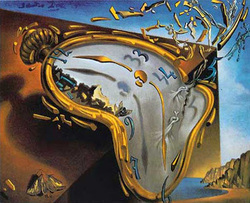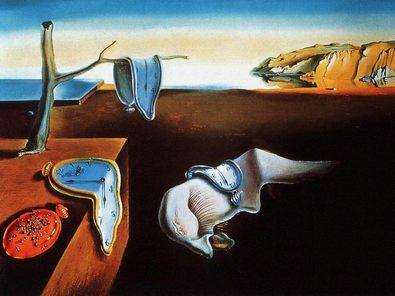Have you ever heard of Salvador Dali Clocks? Perhaps the most
famous clockwork art work in history could be the clocks by Salvador Dali. His
melting clocks have established a huge variety of clocks.
His eye-catching clocks has been utilized in a great many art
work designs, but his surreal masterpieces which look like clocks melting or
distorted were first brought to life by Dali, capturing the world’s imagination.
Dali was born in Spain in 1904 in an area known as Figueres,
Spain. Dali’s very early work was predominantly charcoal sketches influenced by
the painter Ramon Pichot. Overtime Dali started to get a lot of attention after
adopting a style which he coined Cubism. During his time at Art academy he was
expelled as he thought his tutors weren't good enough to judge his work.
Just about everything about Dali was creative including his
image. Dali donned a handlebar moustache which he often modelled in different
ways. There's even a renowned photograph of flowers attached to the end of his
moustache.
Dali was influenced by several things such as the famous artists
Picasso and Raphael. As his very own style evolved he became well-known for his
surreal illustrations. His use of clocks as part of his paintings has influenced
clock designers to produce melting clocks which may be placed on shelves
drooping downwards. They are popular and bought from many retailers.
famous clockwork art work in history could be the clocks by Salvador Dali. His
melting clocks have established a huge variety of clocks.
His eye-catching clocks has been utilized in a great many art
work designs, but his surreal masterpieces which look like clocks melting or
distorted were first brought to life by Dali, capturing the world’s imagination.
Dali was born in Spain in 1904 in an area known as Figueres,
Spain. Dali’s very early work was predominantly charcoal sketches influenced by
the painter Ramon Pichot. Overtime Dali started to get a lot of attention after
adopting a style which he coined Cubism. During his time at Art academy he was
expelled as he thought his tutors weren't good enough to judge his work.
Just about everything about Dali was creative including his
image. Dali donned a handlebar moustache which he often modelled in different
ways. There's even a renowned photograph of flowers attached to the end of his
moustache.
Dali was influenced by several things such as the famous artists
Picasso and Raphael. As his very own style evolved he became well-known for his
surreal illustrations. His use of clocks as part of his paintings has influenced
clock designers to produce melting clocks which may be placed on shelves
drooping downwards. They are popular and bought from many retailers.
The Salvador Dali melting clock originates from The Persistence
of Memory (novel). The melting clock is in the painting by Salvador Dali and is
one of his most well-known pieces. It was painted in 1931. The painting was
first shown inside the Julien Levy Gallery in 1932. Since 1934 the art work has
been shown inside the museum of Modern Art in New York, where it’s one of the
most popular exhibits.
The picture depicts a soft melting pocket watch. The melting
watch is said to reflect Dali’s theory of ‘hardness’ and ‘softness’ this was
part of his thinking at that time in his career. It was considered at the time
that Dali’s motivation originated from Albert Einstein’s theory of Relativity.
However when Salvador Dali was asked about this, Dali declared that in fact the
soft watches or clocks were not influenced by Einstein’s theory but by the
surrealist vision of ‘Camembert cheese melting in the
sun.’
It is known that the human figure in the centre of the art work
is in fact Dali himself. The abstract nature of the painting became something of
a self-portrait. He often did this on his other works. The orange decorated
clock in the bottom left-hand corner has ants on it. Dali painted ants to
symbolise death in his paintings.
The figure in the heart of the painting symbolizes a‘fading’
creature. This is thought to demonstrate that in dreams, the dreamer can’t
generally recognize the makeup or form of an animal. The animal in the artwork
has lots of eyelashes and one closed eye possibly showing the animal is also
within a dream state. The painting might be interpreting Dali’s dreams where the
timepieces show the passing of time as one experiences it during sleep, or how
dreams may feel to us.
The spectacular rocks on the right hand side of the art work is
based on the end of Cap de Creus peninsula in the north of Catalonia. In a great
many other of his works you will notice inspiration from Catalonia landscapes
which influenced him. The dark shadow in the background of the painting is
reference to Mount Pani.
of Memory (novel). The melting clock is in the painting by Salvador Dali and is
one of his most well-known pieces. It was painted in 1931. The painting was
first shown inside the Julien Levy Gallery in 1932. Since 1934 the art work has
been shown inside the museum of Modern Art in New York, where it’s one of the
most popular exhibits.
The picture depicts a soft melting pocket watch. The melting
watch is said to reflect Dali’s theory of ‘hardness’ and ‘softness’ this was
part of his thinking at that time in his career. It was considered at the time
that Dali’s motivation originated from Albert Einstein’s theory of Relativity.
However when Salvador Dali was asked about this, Dali declared that in fact the
soft watches or clocks were not influenced by Einstein’s theory but by the
surrealist vision of ‘Camembert cheese melting in the
sun.’
It is known that the human figure in the centre of the art work
is in fact Dali himself. The abstract nature of the painting became something of
a self-portrait. He often did this on his other works. The orange decorated
clock in the bottom left-hand corner has ants on it. Dali painted ants to
symbolise death in his paintings.
The figure in the heart of the painting symbolizes a‘fading’
creature. This is thought to demonstrate that in dreams, the dreamer can’t
generally recognize the makeup or form of an animal. The animal in the artwork
has lots of eyelashes and one closed eye possibly showing the animal is also
within a dream state. The painting might be interpreting Dali’s dreams where the
timepieces show the passing of time as one experiences it during sleep, or how
dreams may feel to us.
The spectacular rocks on the right hand side of the art work is
based on the end of Cap de Creus peninsula in the north of Catalonia. In a great
many other of his works you will notice inspiration from Catalonia landscapes
which influenced him. The dark shadow in the background of the painting is
reference to Mount Pani.

In 1954 Dali came back to his well-known painting the Persistence of Memory with the Disintegration of the Persistence of Memory. This revealed
his earlier popular painting breaking down into fragments, and a variety of
rectangular shapes with gaps between and more melting clocks.
his earlier popular painting breaking down into fragments, and a variety of
rectangular shapes with gaps between and more melting clocks.
| Also in1954 Dali released another renowned stop-watch piece of art titled ‘Soft Watch at Moment of First Explosion’ showing a soft watch breaking apart. With items of watch and debris close to the watch it gives the look its disintegrating. The art work was much like the ‘Persistence of Memory’ with the back ground being a wasteland and sea scape. In this image the clock dominates the painting with the stop watch sagging over a block shape. In the 1970’s Dali began developing a range of clock timepiece masterpieces. Each including clock faces. They include the usual melting time clock face. ‘Stillness of Time’ which was created in 1979 shows a golden rimmed clock along with a flexible, bendy clock. The clock seems to be wearing some sort of crown; interestingly the clock has tree twigs and roots. Dali produced a similar piece called ‘Tearful soft watch Giclee’ showing a stop watch hung over a leafless tree. |
One intriguing timepiece he produced was the ‘Clock B Giclee’
since it was quite different from his other clock pieces. The clock looks very
different from an average clock with no hands and numbers. This clock dangles
from a barren tree (which he often used) along with a multi coloured clock. You
have to look closely to identify that it is a clock hanging from the branch.
Dali later in his career made sculptures showing melting watches
and clocks. ‘Horse Saddled with Time’ is a good example of this because of the
clock face draped over the back of the horse instead of a saddle. The sculpture
is recognized as one of his best sculptures and valued very highly.‘Danse Du
Temp’ is another fine illustration of his sculptures. The clock is stretched and
deformed using black and gold shades.
As with all his work, the clocks he styles are thin expressing
time is sliding away in Dali’s world. In Dali’s perspective the clocks are
falling down showing they're like dreams as they are easily forgotten and
difficult to see clearly. The clocks and animals seem to be breaking up or dying
implying time passes on and slips away.
The ‘Horse saddled with Time’ sculpture shows time being a
burden, with the animal quickly taking the burden away. Similarly dead plants
and twigs can often be seen in Dali work. This is thought to reflect how time
can appear to drain living things of energy. However it is really down to the
person how they experience his art and what meaning they conclude from it.
Currently two museums have been created to honour his life and
work. One museum is found in his hometown of Figueres, Spain. The other is in St
Petersburg, Florida. At the museums you can view his photography and films he
made.
If you wish to know more about the person then I highly recommend
you read his autobiography. Dali was certainly not boring so his autobiography
is certainly interesting. If you’re enthusiastic about his work you can easily
acquire prints of his work at affordable prices. Some of his authentic pieces of
work now sell for thousands of pounds.
Maybe purposely Dali created a whole genre of clock designs
driven by his works. Salvador Dali inspired clocks are as popular today as ever.
since it was quite different from his other clock pieces. The clock looks very
different from an average clock with no hands and numbers. This clock dangles
from a barren tree (which he often used) along with a multi coloured clock. You
have to look closely to identify that it is a clock hanging from the branch.
Dali later in his career made sculptures showing melting watches
and clocks. ‘Horse Saddled with Time’ is a good example of this because of the
clock face draped over the back of the horse instead of a saddle. The sculpture
is recognized as one of his best sculptures and valued very highly.‘Danse Du
Temp’ is another fine illustration of his sculptures. The clock is stretched and
deformed using black and gold shades.
As with all his work, the clocks he styles are thin expressing
time is sliding away in Dali’s world. In Dali’s perspective the clocks are
falling down showing they're like dreams as they are easily forgotten and
difficult to see clearly. The clocks and animals seem to be breaking up or dying
implying time passes on and slips away.
The ‘Horse saddled with Time’ sculpture shows time being a
burden, with the animal quickly taking the burden away. Similarly dead plants
and twigs can often be seen in Dali work. This is thought to reflect how time
can appear to drain living things of energy. However it is really down to the
person how they experience his art and what meaning they conclude from it.
Currently two museums have been created to honour his life and
work. One museum is found in his hometown of Figueres, Spain. The other is in St
Petersburg, Florida. At the museums you can view his photography and films he
made.
If you wish to know more about the person then I highly recommend
you read his autobiography. Dali was certainly not boring so his autobiography
is certainly interesting. If you’re enthusiastic about his work you can easily
acquire prints of his work at affordable prices. Some of his authentic pieces of
work now sell for thousands of pounds.
Maybe purposely Dali created a whole genre of clock designs
driven by his works. Salvador Dali inspired clocks are as popular today as ever.


 RSS Feed
RSS Feed